Enhanced Ductility of a W-30Cu Composite by Improving Microstructure Homogeneity
Abstract
:1. Introduction
2. Materials and Methods
2.1. W-Cu and W Skeleton
2.2. Experimental Method
2.3. Simulation Model
3. Results and Discussion
3.1. Microstructure Characteristics
3.2. Tensile Test
3.3. Compression Test
4. Conclusions
- The selected tungsten powders were compacted by isostatic cool pressing at 100 MPa to obtain a W skeleton. The W-30Cu composite was prepared via infiltrating molten copper into the W skeleton. The prepared W-30Cu composite exhibits homogeneous phase distribution feature and continuous Cu phase network structure.
- Quasi-static tensile tests of W-30Cu composites with a different homogeneity of phase distribution were investigated. It was found that tensile elongation of the SCI composite is 10.2% while the BCI composite is only 6.51% at room temperature. It was confirmed that the homogeneous phase distribution feature and continuous network structure are responsible for a high capacity of plastic deformation in the W-30Cu composites. Further, as a function of temperature, both the SCI and BCI composite display a similar ductile evolution with an increase in temperature. In addition, their tensile elongation reaches a maximum of 16.7% and 14.1% for the SCI composite and the BCI composites, respectively, at 300 °C.
- Hollow cylindrical specimens were applied to study the effect of microstructure homogeneity on strength and ductility of the W-30Cu composites under a dynamic compression condition. The SCI composite exhibits an excellent plastic deformation capacity due to its homogenous distribution feature and continuous network structure. The micro-cracks nucleate randomly instead of concentrating on the location of the W phase agglomeration due to the homogeneous phase distribution feature, and the micro-cracks can be prohibited and compensated by the coordinated deformation of the continuous copper network.
Author Contributions
Funding
Acknowledgments
Conflicts of Interest
References
- Li, J.; Deng, N.; Wu, P.; Zhou, Z. Elaborating the Cu-network structured of the W–Cu composites by sintering intermittently electroplated core-shell powders. J. Alloys Compd. 2019, 770, 405–410. [Google Scholar] [CrossRef]
- Meng, Y.; Shen, Y.; Chen, C.; Li, Y.; Feng, X. Effects of Cu content and mechanical alloying parameters on the preparation of W–Cu composite coatings on copper substrate. J. Alloys Compd. 2014, 585, 368–375. [Google Scholar] [CrossRef]
- Muller, A.; Ewert, D.; Galatanu, A.; Milwich, M.; Neu, R.; Pastor, J.Y.; Siefken, U.; Tejado, E.; You, J.H. Melt infiltrated tungsten–copper composites as advanced heat sink materials for plasma facing composites of future nuclear fusion devices. Fusion Eng. Des. 2017, 124, 455–459. [Google Scholar] [CrossRef]
- Wang, F.; Guo, W.; Liu, J.; Li, S.; Zhou, J. Microstructural evolution and grain refinement mechanism of pure tungsten under explosive loading condition. Int. J. Refract. Met. Hard Mater. 2014, 45, 64–70. [Google Scholar] [CrossRef]
- Elshenawy, T.; Elbeih, A.; Li, Q.M. A modified penetration model for copper-tungsten shaped charge jet with non-uniform density distribution. Cent. Eur. J. Energetic Mater. 2016, 13, 927–943. [Google Scholar] [CrossRef]
- Wang, F.; Jiang, J.; Men, J.; Bai, Y.; Wang, S.; Li, M. Investigation on shaped charge jet density gradient for metal matrix composites: Experimental design and execution. Int. J. Impact Eng. 2017, 109, 311–320. [Google Scholar] [CrossRef]
- Xi, B.; Liu, J.; Li, S.; Lv, C.; Guo, W.; Wu, T. Effect of interaction mechanism between jet and target on penetration performance of shaped charge liner. Mater. Sci. Eng. A 2012, 553, 142–148. [Google Scholar] [CrossRef]
- Guo, W.; Wang, Y.; Liu, K.; Li, S.; Zhang, H. Effect of Copper Content on the Dynamic Compressive Properties of Fine-grained Tungsten Copper Alloys. Mater. Sci. Eng. A 2018, 727, 140–147. [Google Scholar] [CrossRef]
- Johnson, J.L.; Brezovsky, J.J.; German, R.M. Effect of liquid content on distortion and rearrangement densification of liquid-phase-sintered W-Cu. Metall. Mater. Trans. A 2005, 36, 1557–1565. [Google Scholar] [CrossRef]
- Elsayed, A.; Li, W.; Kady, O.A.E.; Daoush, W.M.; Olevsky, E.A.; German, R.M. Experimental investigations on the synthesis of W–Cu nanocomposite through spark plasma sintering. J. Alloys Compd. 2015, 639, 373–380. [Google Scholar] [CrossRef]
- Hamidi, A.; Arabi, H.; Rastegari, S. Tungsten-copper composite production by activated sintering and infiltration. Int. J. Refract. Met. Hard Mater. 2011, 29, 538–541. [Google Scholar] [CrossRef]
- Ahangarkani, M.; Zangeneh-Madar, K.; Borji, S. Microstructural study on the effect of directional infiltration and Ni activator on tensile strength and conductivity of W-10wt%Cu composite. Int. J. Refract. Met. Hard Mater. 2018, 71, 340–351. [Google Scholar] [CrossRef]
- Ibrahim, H.; Aziz, A.; Rahmat, A. Enhanced liquid-phase sintering of W–Cu composites by liquid infiltration. Int. J. Refract. Met. Hard Mater. 2014, 43, 222–226. [Google Scholar] [CrossRef]
- Li, C.; Zhou, Y.; Xie, Y.; Zhou, D.; Zhang, D. Effects of milling time and sintering temperature on structural evolution, densification behavior and properties of a W-20wt.%Cu alloy. J. Alloys Compd. 2018, 731, 537–545. [Google Scholar] [CrossRef]
- Qiu, W.T.; Pang, Y.; Xiao, Z.; Li, Z. Preparation of W-Cu alloy with high density and ultrafine grains by mechanical alloying and high pressure sintering. Int. J. Refract. Met. Hard Mater. 2016, 61, 91–97. [Google Scholar] [CrossRef]
- Wang, C.P.; Lin, L.C.; Xu, L.S.; Xu, W.W.; Song, J.P.; Liu, X.J.; Yu, Y. Effect of blue tungsten oxide on skeleton sintering and infiltration of W–Cu composites. Int. J. Refract. Met. Hard Mater. 2013, 41, 236–240. [Google Scholar] [CrossRef]
- Zhou, Q.; Chen, P. Fabrication of W–Cu composite by shock consolidation of Cu-coated W powders. J. Alloys Compd. 2016, 657, 215–223. [Google Scholar] [CrossRef]
- Zhang, Q.; Liang, S.; Zhuo, L. Fabrication and properties of the W-30wt%Cu gradient composite with W@WC core-shell structure. J. Alloys Compd. 2017, 708, 796–803. [Google Scholar] [CrossRef]
- Hiraoka, Y.; Inoue, T.; Hanado, H.; Akiyoshi, N. Ductile-to-Brittle Transition Characteristics in W–Cu Composites with Increase of Cu Content. Mater. Trans. 2005, 46, 1663–1670. [Google Scholar] [CrossRef]
- Ahangarkani, M.; Borji, S.; Zangeneh-madar, K.; Valefi, Z.; Ahangarcani, M. Mutual relationship between material removal rate and W-W interfacial features during ultra-high temperature erosion of infiltrated W-10wt.%Cu composite. Int. J. Refract. Met. Hard Mater. 2018, 75, 191–201. [Google Scholar] [CrossRef]
- Tejado, E.; Muller, A.V.; You, J.-H.; Pastor, J.Y. The thermo-mechanical behaviour of W-Cu metal matrix composites for fusion heat sink applications: The influence of the Cu content. J. Nucl. Mater. 2018, 498, 468–475. [Google Scholar] [CrossRef] [Green Version]
- Deng, N.; Zhou, Z.; Li, J.; Wu, Y. W-Cu composites with homogenous Cu-network structure prepared by spark plasma sintering using core-shell powders. Int. J. Refract. Met. Hard Mater. 2019, 82, 310–316. [Google Scholar] [CrossRef]
- Montealegre-Meléndez, I.; Arévalo, C.; Perez-Soriano, E.W.; Neubauer, E.; Rubio-Escudero, C.; Kitzmantel, M. Analysis of the Influence of Starting Materials and Processing Conditions on the Properties of W/Cu Alloys. Materials 2017, 10, 142. [Google Scholar] [CrossRef] [PubMed]
- Zheng, L.; Liu, J.; Li, S.; Wang, G.; Guo, W. Investigation on preparation and mechanical properties of W–Cu–Zn alloy with low W–W contiguity and high ductility. Mater. Des. 2015, 86, 297–304. [Google Scholar] [CrossRef]
- Laporte, V.; Mortensen, A. Intermediate temperature embrittlement of copper alloys. Int. Mater. Rev. 2009, 54, 94–116. [Google Scholar] [CrossRef] [Green Version]
- Tejado, E.; Muller, A.V.; You, J.-H.; Pastor, J.Y. Evolution of mechanical performance with temperature of W/Cu and W/CuCrZr composites for fusion heat sink applications. Mater. Sci. Eng. A 2018, 712, 738–746. [Google Scholar] [CrossRef] [Green Version]
- Zivelonghi, A.; You, J.-H. Mechanism of plastic damage and fracture of a particulate tungsten-reinforced copper composite: A microstructure-based finite element study. Comput. Mater. Sci. 2014, 84, 318–326. [Google Scholar] [CrossRef]
- Guo, W.; Liu, J.; Li, S.; Wang, Y.; Ji, W. Microstructural evolution and deformation mechanism of the 80W-20Cu alloy at ultra-high strain rates under explosive loading. Mater. Sci. Eng. A 2013, 572, 36–44. [Google Scholar]
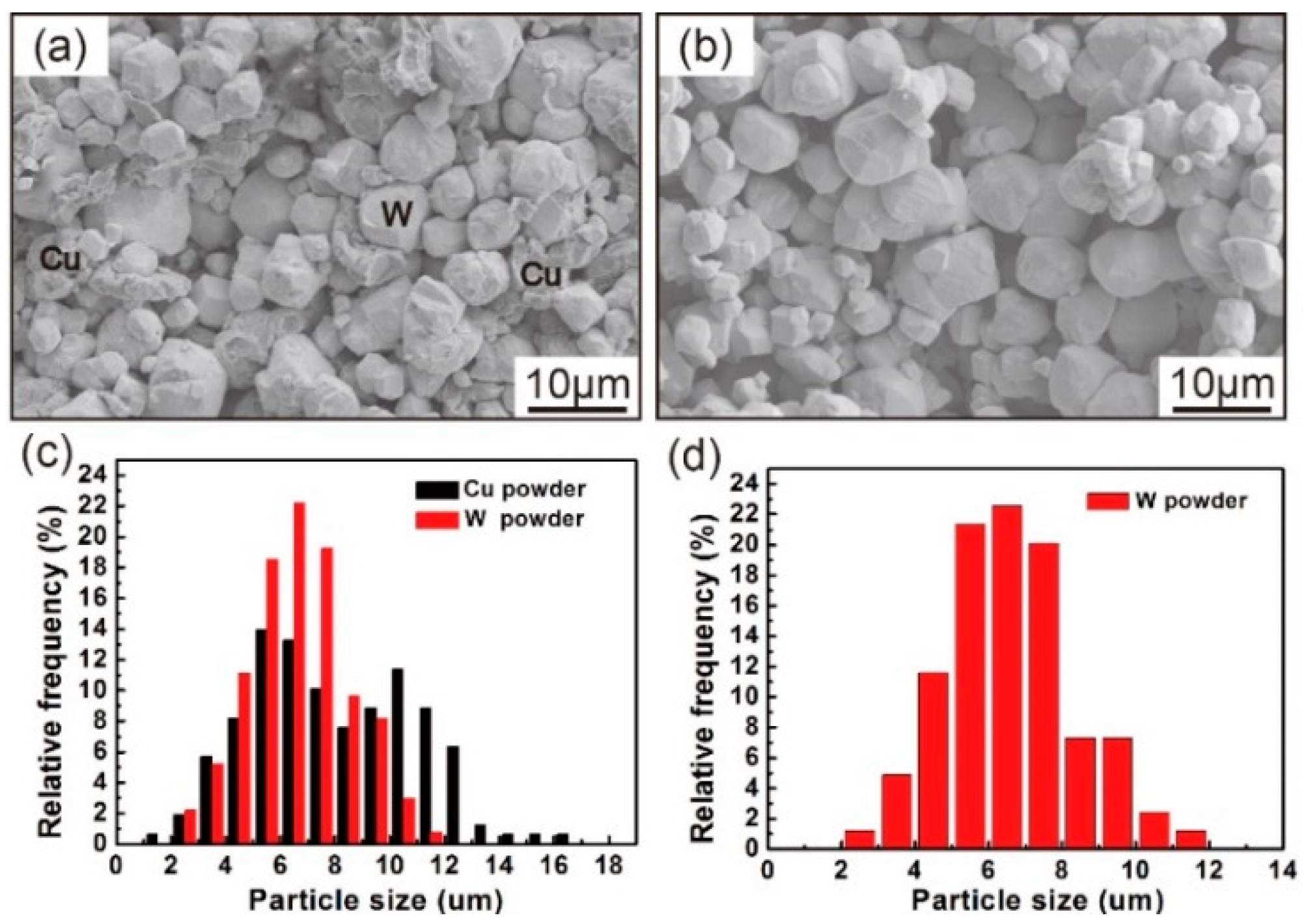
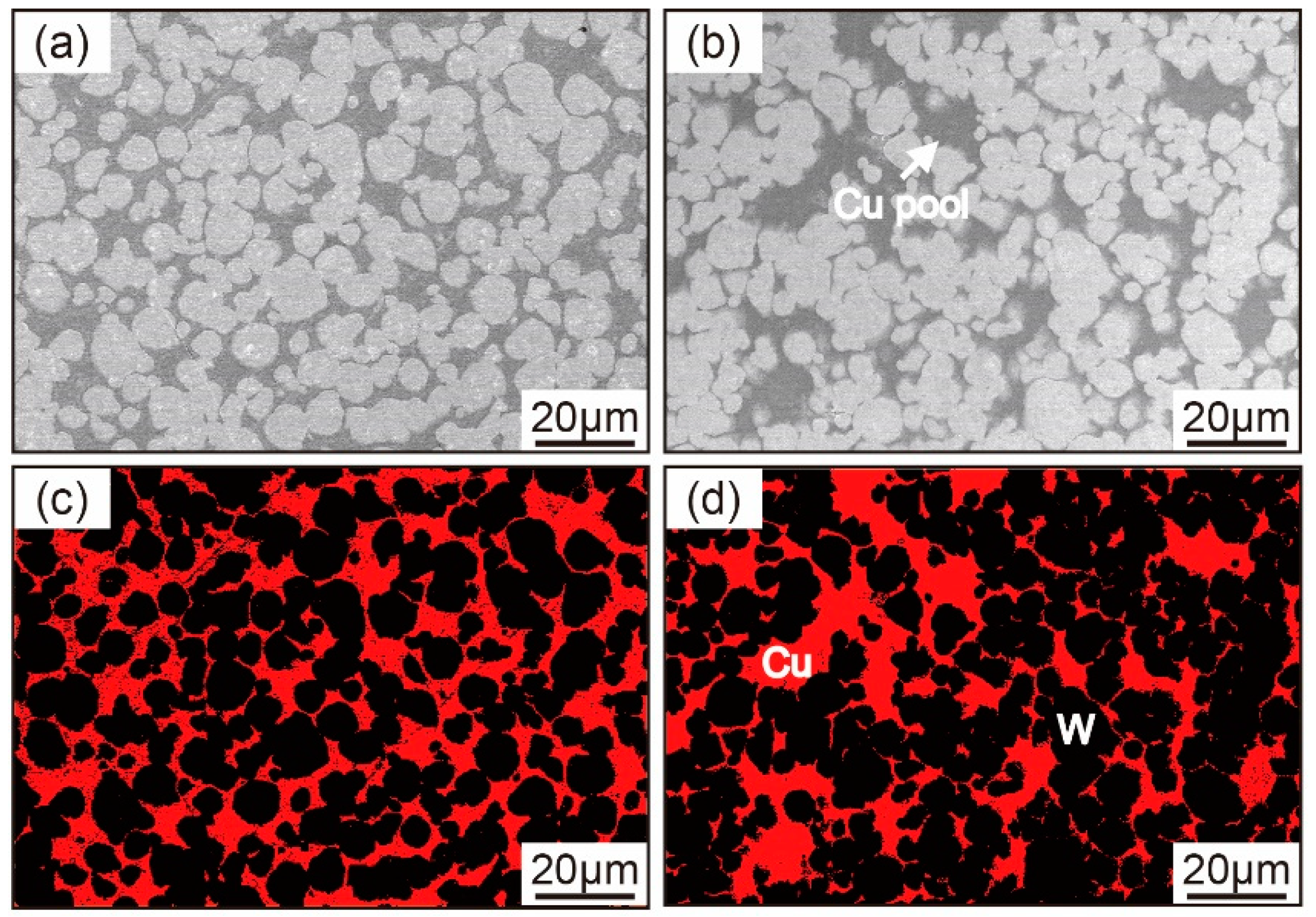
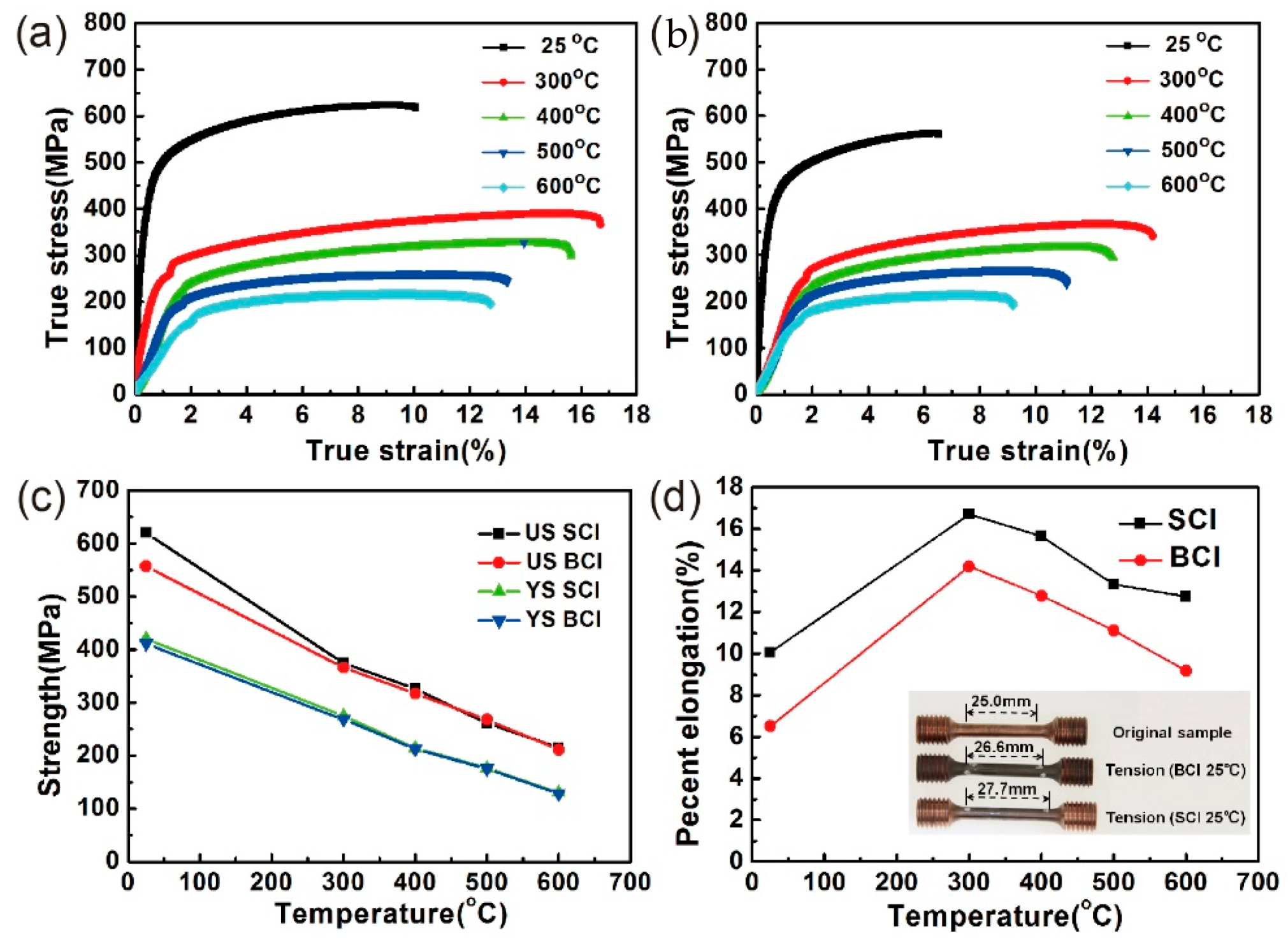
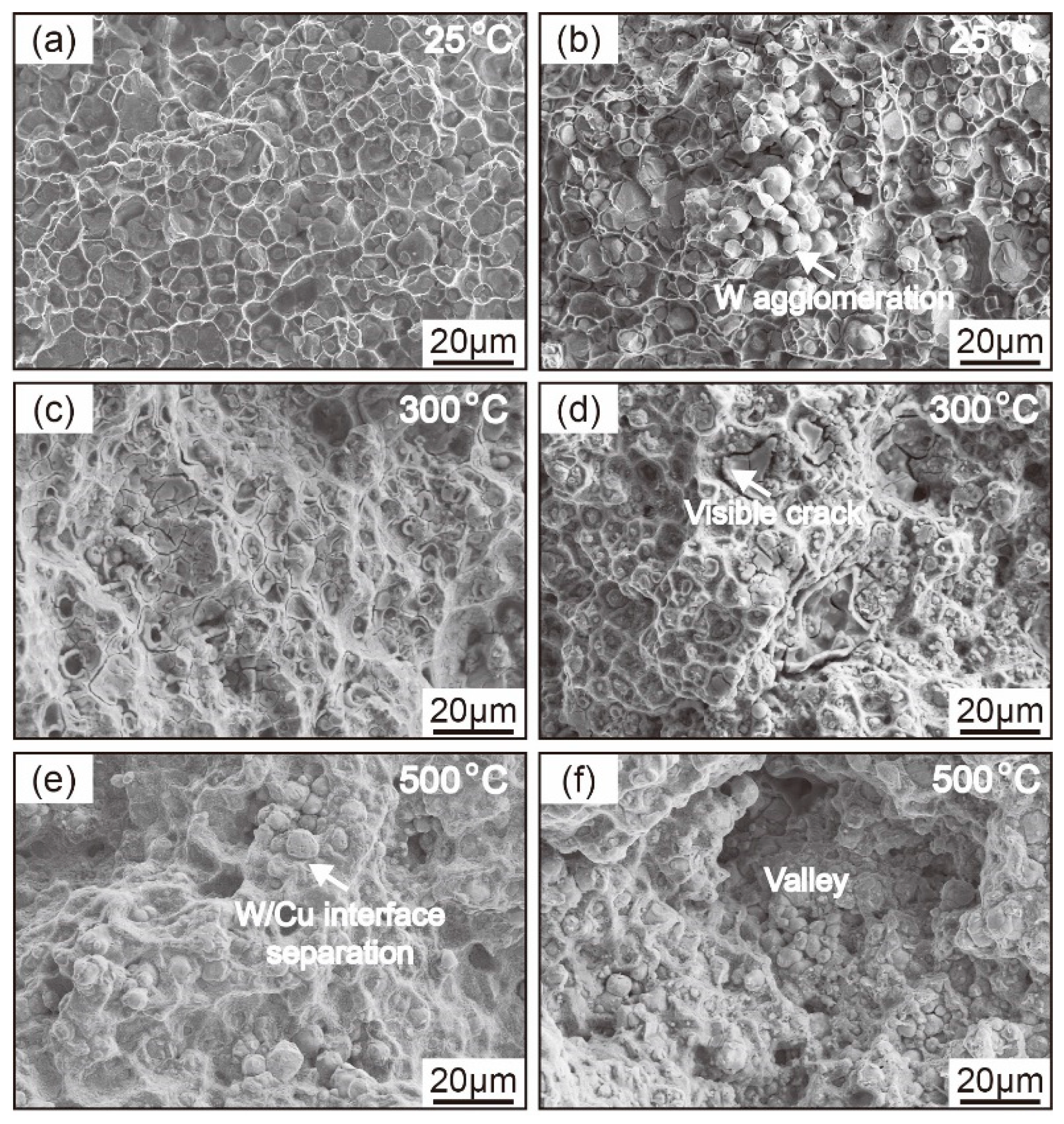
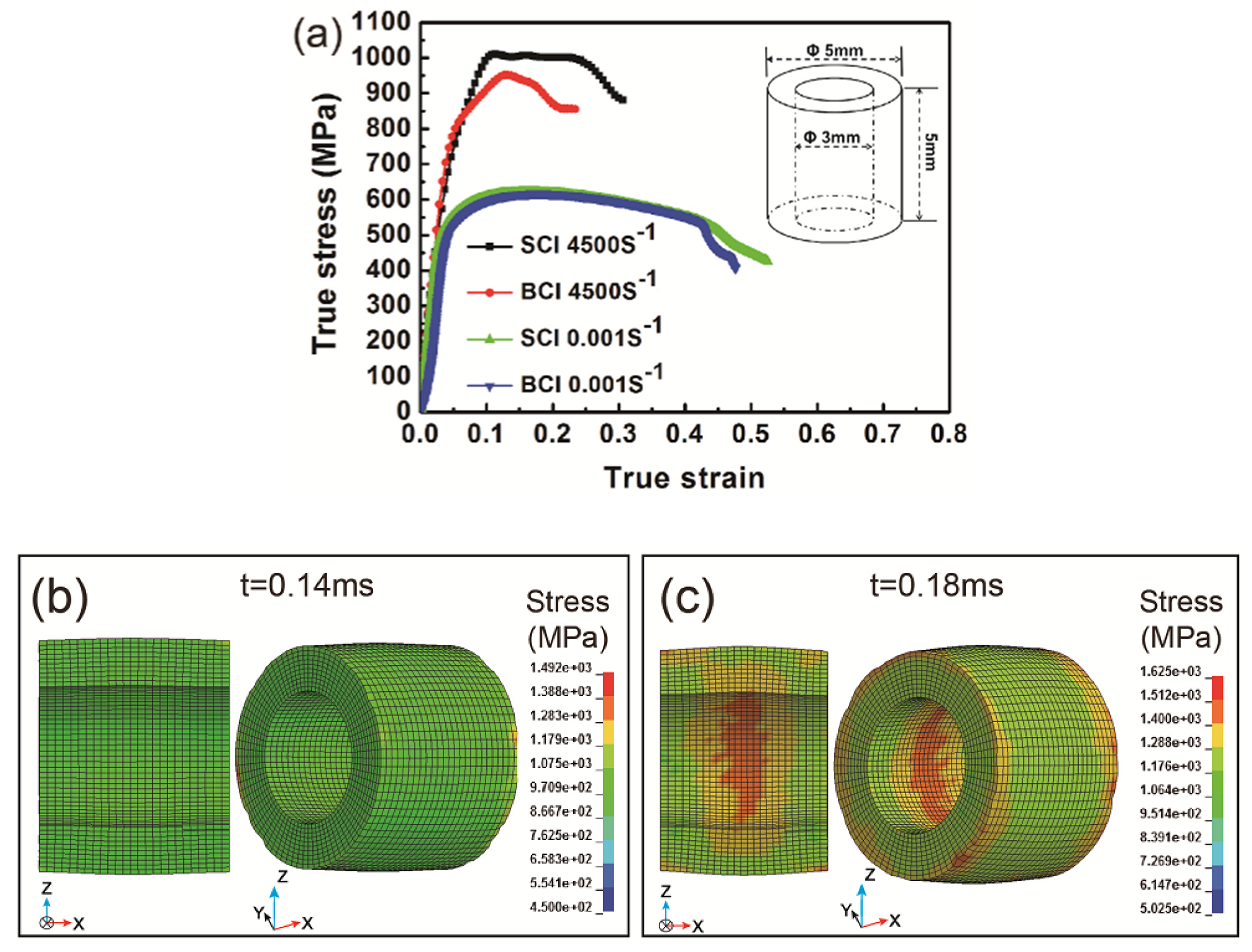

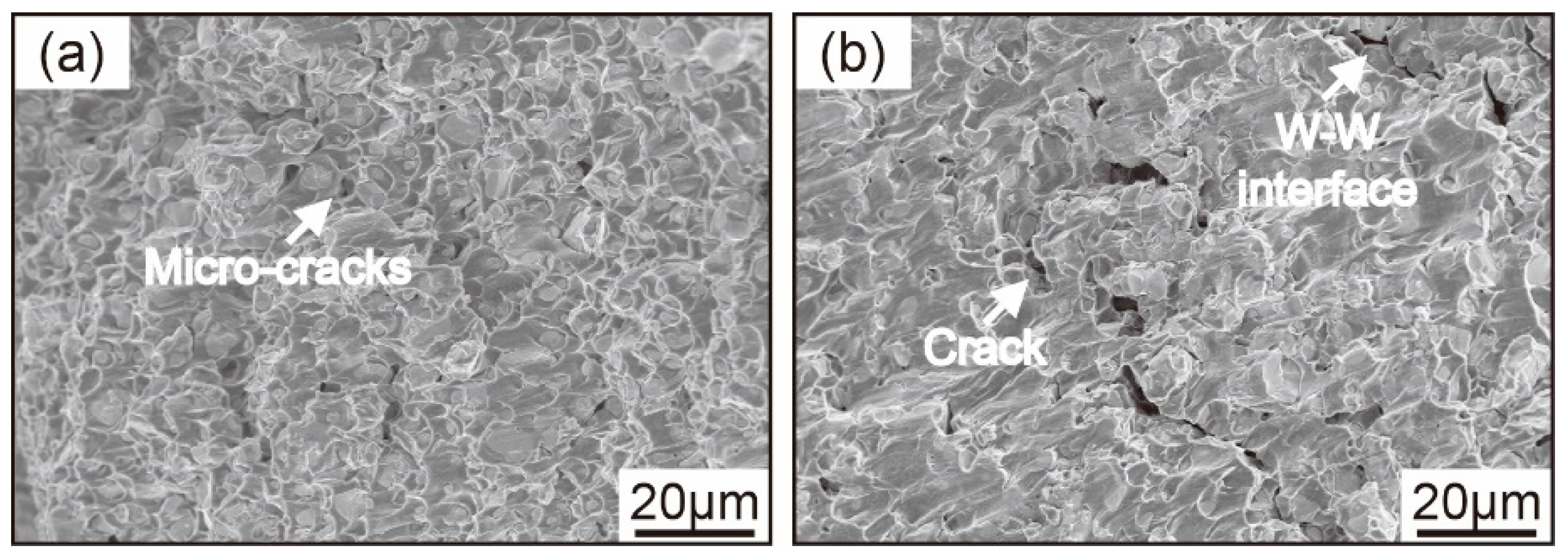
| Quantity | Symbol | Value | Unit |
|---|---|---|---|
| Young’s modulus | E | 195 | GPa |
| Poisson’s ratio | Μ | 0.35 | - |
| Material density | ρ | 14,330 | Kg/m3 |
| Quantity | SCI Composite | BCI Composite |
|---|---|---|
| Relative density | 98.5% | 97.6% |
| Distribution homogeneity DU | 9.09 | 0.70 |
| W-W contiguity CW-W | 0.38 | 0.49 |
© 2019 by the authors. Licensee MDPI, Basel, Switzerland. This article is an open access article distributed under the terms and conditions of the Creative Commons Attribution (CC BY) license (http://creativecommons.org/licenses/by/4.0/).
Share and Cite
Hao, Z.; Liu, J.; Cao, J.; Li, S.; Liu, X.; He, C.; Xue, X. Enhanced Ductility of a W-30Cu Composite by Improving Microstructure Homogeneity. Metals 2019, 9, 646. https://doi.org/10.3390/met9060646
Hao Z, Liu J, Cao J, Li S, Liu X, He C, Xue X. Enhanced Ductility of a W-30Cu Composite by Improving Microstructure Homogeneity. Metals. 2019; 9(6):646. https://doi.org/10.3390/met9060646
Chicago/Turabian StyleHao, Zehui, Jinxu Liu, Jin Cao, Shukui Li, Xingwei Liu, Chuan He, and Xinying Xue. 2019. "Enhanced Ductility of a W-30Cu Composite by Improving Microstructure Homogeneity" Metals 9, no. 6: 646. https://doi.org/10.3390/met9060646




